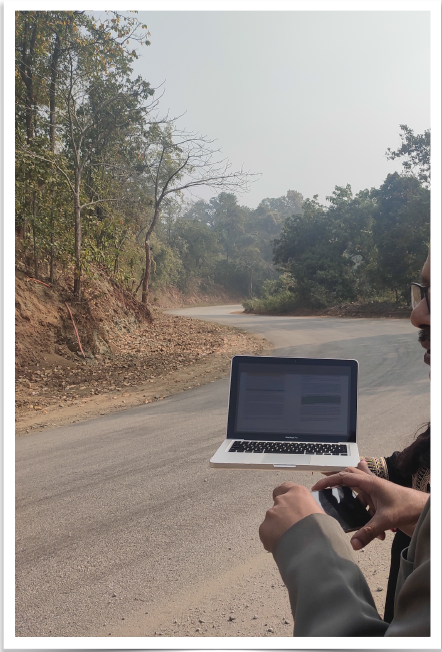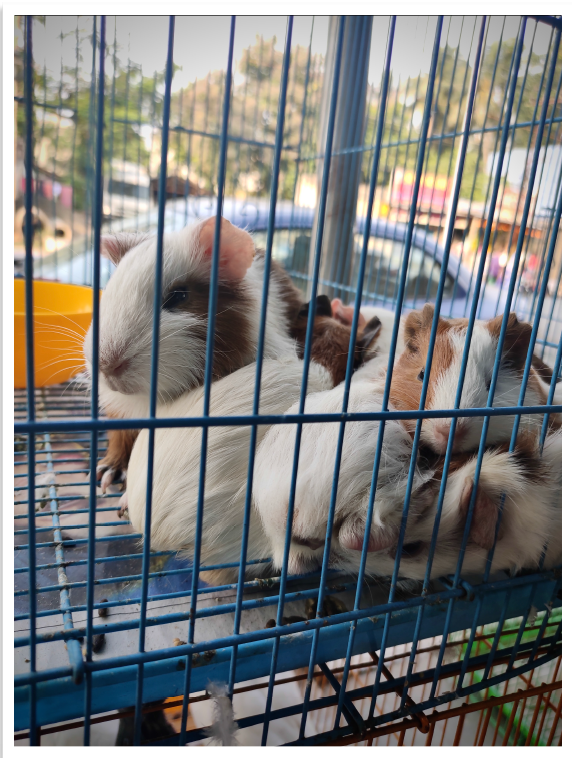Beyond Virtual, Through Pandemic: A Photo Essay

Illustration 1: Who replaced whom: Mountains or the virtual screen? The mountains that we intended to scale, and the rivers that we dreamt to sail, became easier and uncomplicated, while the mundane chores became laborious and demanding.
The virtual screens, camouflaged with the canopy of trees, were shadowed with the conversations that were once intimate.
The past year, we all spent our days, looking at the world that seemed to have stood still but moved at the speed that no one could have envisioned. The only window that equipped us with the power to connect. Through these tiny virtual screens, we accomplished the
deadlines that seemed endless in the real world. The virtual mountains that seemed challenging to conquer were no longer unachievable.
But the real mountains?
The everyday duties that once were simple, effortlessly achievable became a gigantic task when the virtual and the real swapped. While the dream to climb and scale the mountains is highly unlikely in the present, what changed is our priorities and perception of the way we perceive.
Beyond the virtual screens, what remains, is our vision to conquer and overcome the possibilities.
Illustration 2: Our dependance on the flickering traces of life among the fabricated, non living
things, became more prominent and evident. The search for ‘life’ during the virtual meetings
continued.
Advertisements on television and radio broadcasts replaced flyers and posters that were the mediums of conveying information during the pandemic of 1918. The clear distinction of the metamorphoses of the medium of communication of the first pandemic into the current generation’s heavily connected network shows the ever-evolving modes of communication. Be it Mr Bachchan asking you to take precautions in his deep, baritone, or the news headlines and the changing statistics on the worldometer, the medium of communication changed, taking the shape of a digital world that was connected. When the social media platforms became the messenger, the news’s bearer connected us with our families.
When work from home replaced us with machines that had no significant work hours. The keyboards and keypads became the homing pigeons that delivered our messages through the letters and alphabets.
Illustration 3: When placed in the real world, the
virtual becomes a muse, prompting it to be a subtle
reminder of not belonging
The real and the Virtual have become tangible, something that is difficult to differentiate and discern. The nature that we saw through our virtual screens led us through the intricate and tangled maze, towards the twinkling ray of light at the end of the tunnel.
The pandemic brought a radical change when physical schools were interchanged with the virtual classrooms, doors to the classes substituted with hyperlinked words, and the ‘quietness’ of the students replaced the ‘silence’ of the blank tiles on the screen. Assignments and everyday tasks became ‘collective responsibility’.
The pandemic’s most striking effect was the lockdown that entailed the intention of ‘saving’ the humankind. While we were conditioned to run the race of life, a temporary ‘shutdown’ jolted us to take a brief pause and look around. The virtual world held our networked connections, firm, closely knit, but captivated our minds into a ‘new normal’. In his book, Marshall McLuhan, the medium is the message, uses the example of a light bulb to describe how much ‘content’ is essential to a medium of communication. The quest for seeking ‘content’ in the virtual world became the medium that helped us convey, as it replaced the physical contacts.
Illustration 4: Through the cage, we held on to our dear ones, anxious
and uncertain.
“We are too prone to make technological instruments the scapegoats for the sins of those who wield them. The products of science are not in themselves good or bad; it is the way they are used that determines their value.” (David Sarnoff)
While the medium of communication interweaved into the virtual world’s fabric, the increased screen time increased anxieties. According to a study conducted by a group of researchers, anxiety levels were higher among the parents and children who were using social media to connect (Drouin, McDaniel, Pater and Toscos, 732). This brings us back to Marshall McLuhan where he said how the present-day world is a ‘global’ village, brought together to form the ‘Age of anxiety’ by the electric media that has become the medium (McLuhan, 8).
Illustration 5: The dawn of ‘new normal’
The pandemic has tested the networking webs that we have weaved over the years of our existence. The interchanged realities of what is real and virtual have complicated the way we perceive the world. While we may have shifted and adapted to a different ‘normal’, the need for a medium to narrate and communicate our stories and ‘content’ remains the same, like it was back during the first pandemic. The accessibility to the information and its broadcasting has become quicker, but the words that we use to emote on a virtual platform, remain camouflaged in the complex web of networks.
Pandemics and humankind have, time and again, reinstated the mediums that we use to connect, communicate and interact. Virtual platforms that replaced the real individuals Illustration 5: The dawn of ‘new normal’ failed to create the ‘intimate’ spaces of conversations and were limited to conveying information without emotion. How strange is this experience, isn’t it? The more that we are connected virtually, the more that we seek intimacy and ‘real’. The more we stay away from nature, the more we crave walking on the river beds, undisguised, unadorned, and unwary of the virtual world that develops and grows every day.
REFERENCES
Drouin, M., McDaniel, B. T., Pater, J., & Toscos, T. (2020). How parents and their children used social media and technology at the beginning of the COVID-19 pandemic and associations with anxiety. Cyberpsychology, Behavior, and Social Networking, 23(11),
727-736.
McLuhan, M. (1964). The medium is the message.






